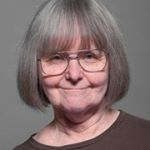Information Box Group
Suzanna Becker
Faculty Emeritus
Cognition / Perception – Systems & Behavioural Neuroscience
What pre-requisites do you look for when evaluating a potential thesis student?
The minimum CA of a 4D09 is 8.5; the miminum CA for a 4D06 is 8.0.
What information are you going to want from a student who is interested in working in your lab?
Student’s grades will be retried by the ballot system once the balloting process is completed.
How do you want to be contacted?
I will evaluate applications on the ballot system once the ballot closes. You may contact me by e-mail, however, I may not respond until I evaluate the applications submitted through the ballot.
Computational and cognitive neuroscience of leaing and memory
Richard Day
People Card Modal Dialog
Although in the distant past I conducted research in basic instrumental conditioning processes in small, furry animals, I have devoted my time for the past 25 years or so to undergraduate instruction.
Geoffrey Hall
Faculty Emeritus
Cognition / Perception – Developmental Psychology – Systems & Behavioural Neuroscience – Research & Clinical Training
His interests broadly encompass the neurological foundations of human emotion and cognition, with a particular focus on neurodevelopmental disorders and psychopathology. Central to this work is the development of novel experimental and theoretical tools that lead to a deeper understanding of how emotion and cognition are mapped onto the developing brain, and how underlying neural systems aggregate into functionally connected networks. His research places an emphasis on the development of strong validated behavioural paradigms and draws upon a range of imaging methodologies, including functional Magnetic Resonance Imaging, Magnetic Resonance Spectroscopy, Diffusion Tensor Imaging, MRI Cortical Thickness & Volumetry, Positron Tomography and Electroencephalography
Daphne Maurer
Distinguished University Professor
Daphne M. Maurer, FRSC
(PhD, Minnesota)
maurer@mcmaster.ca
I am retired but continue to do research and occasionally I supervise students’ projects. The aim of my research is to understand development—the way in which different types of experience effect change during normal development, how those changes are constrained by the biology of the organism, the way in which the nervous system is able to recover from some perturbations, and the limits to plasticity. To examine these questions about development, I study visual perception, both its development in children with normal eyes and its alteration in children with a history of visual deprivation from cataracts.
The normal development of perception. We investigated developmental changes involving visual capabilities mediated at different levels of the visual pathway: sensitivity to orientation and local motion, which are mediated mainly by the geniculatestriate pathway; integration of local elements into a global percept of form and a global direction of motion, which involve additional processing in extrastriate cortex; the perception of faces, which involves specialized mechansims in the temporal cortex; and the integration of the senses beyond the visual pathway. By using marker tasks for different parts of the visual pathway, we made inferences from the behavioural patte about the developing nervous system, and sometimes confirmed the inferences using event-related potentials and functional Magnetic Resonance Imaging. Our studies indicated that some capabilities are present during the first hour after birth, but that others, such as expertise in identifying faces, take more than 14 years to become adultlike.
The visual development of children treated for cataracts. At The Hospital for Sick Children in Toronto, we are studying the visual development of children who were deprived of normal visual input until they had surgery to remove dense central cataracts and were fitted with contact lenses. These children allow us to evaluate the effects of visual deprivation on development, including the influence of its timing and duration. We are following over 100 children, the largest research population of this type in the world. Current studies involve cross-model perception and integration.
The psychobiological roots of aesthetics. We normally assume that adults’ judgments of beauty are based on cultural stereotypes. Yet 2-month-old infants look longer at a face rated attractive by adults than at a face rated unattractive. Findings like these suggest that some of adults’ preferences are rooted in the way the human nervous system works. We conducted developmental and cross-cultural studies to identity the nature of the biological constraint.
Vision screening. About 15% of kindergarten children have visual deficits that are treatable but undiagnosed. We are researching the best tools for screening their vision and the practicality of implementing it in schools.
My interest in the development of perception led to a book with Charles Maurer, The World of the Newbo. In this we integrated the science of infant perception to work out what a young baby perceives from the baby’s perspective. It won the book award of the American Psychological Association and has been translated into five languages.
My interest in the roots of aesthetics led to a new and comprehensive framework that grounds aesthetics in the basics of physics and biology, and carries it through all art forms across cultures. This Charles Maurer and I adumbrated in the book Pretty Ugly: Why we like some songs, faces, foods, plays, pictures, poems, etc., and dislike others. This framework we are currently applying to human social behaviour in a book that we are tempted to entitle Prettier and Uglier.
Allison Sekuler
Faculty Emeriti
Cognition / Perception – Developmental Psychology – Systems & Behavioural Neuroscience
What Pre-Requisites Do You Look For When Evaluating A Potential Thesis Student?
Students should have good grades in perception and/or neuroscience courses (e.g., 2E03, 2F03, 3D03). Statistical/computational/coding skills are an asset.
What Information Are You Going To Want From A Student Who Is Interested In Working In Your Lab?
It would be helpful to receive a copy of your transcript and a brief description of your reasons for wanting to join my lab.
How Do You Want To Be Contacted?
Please email me and make it clear in the subject heading that you want to do a thesis or independent study.
Vision, cognitive neuroscience, EEG, aging, face perception, perceptual leaing, neural plasticity, Alzheimer’s and related dementias, neurotechnology
Judith Shedden
Faculty Emeritus
Cognition / Perception – Systems & Behavioural Neuroscience
What pre-requisites do you look for when evaluating a potential thesis student?
Students should have a strong background in cognition, perception, and neuroscience, good grades in statistics, and a cumulative GPA of at least 10.0. Undergraduates work in teams with graduate students on EEG/ERP and behavioural projects, asking questions about cognitive and social aspects of leaing.
What information are you going to want from a student who is interested in working in your lab?
Please send your CV and transcripts and a brief statement about why you’d like to work in my lab.
How do you want to be contacted?
Please email me.
Attention, cognitive control, multisensory processing, self-motion perception, spatial navigation, full-motion driving simulator
We are a cognitive science research group in the department of Psychology, Neuroscience, and Behaviour at McMaster University. We investigate self-motion perception, multisensory integration, route navigation, cognitive benefits of mindfulness meditation, and other aspects of cognitive control using a motion simulator and scalp electrophysiology.
Suzanna Becker
Faculty Emeritus
Cognition / Perception – Systems & Behavioural Neuroscience
What pre-requisites do you look for when evaluating a potential thesis student?
The minimum CA of a 4D09 is 8.5; the miminum CA for a 4D06 is 8.0.
What information are you going to want from a student who is interested in working in your lab?
Student’s grades will be retried by the ballot system once the balloting process is completed.
How do you want to be contacted?
I will evaluate applications on the ballot system once the ballot closes. You may contact me by e-mail, however, I may not respond until I evaluate the applications submitted through the ballot.
Computational and cognitive neuroscience of leaing and memory
Suzanna Becker
Faculty Emeritus
Cognition / Perception – Systems & Behavioural Neuroscience
What pre-requisites do you look for when evaluating a potential thesis student?
The minimum CA of a 4D09 is 8.5; the miminum CA for a 4D06 is 8.0.
What information are you going to want from a student who is interested in working in your lab?
Student’s grades will be retried by the ballot system once the balloting process is completed.
How do you want to be contacted?
I will evaluate applications on the ballot system once the ballot closes. You may contact me by e-mail, however, I may not respond until I evaluate the applications submitted through the ballot.
Computational and cognitive neuroscience of leaing and memory
Richard Day
People Card Modal Dialog
Although in the distant past I conducted research in basic instrumental conditioning processes in small, furry animals, I have devoted my time for the past 25 years or so to undergraduate instruction.
Richard Day
People Card Modal Dialog
Although in the distant past I conducted research in basic instrumental conditioning processes in small, furry animals, I have devoted my time for the past 25 years or so to undergraduate instruction.
Geoffrey Hall
Faculty Emeritus
Cognition / Perception – Developmental Psychology – Systems & Behavioural Neuroscience – Research & Clinical Training
His interests broadly encompass the neurological foundations of human emotion and cognition, with a particular focus on neurodevelopmental disorders and psychopathology. Central to this work is the development of novel experimental and theoretical tools that lead to a deeper understanding of how emotion and cognition are mapped onto the developing brain, and how underlying neural systems aggregate into functionally connected networks. His research places an emphasis on the development of strong validated behavioural paradigms and draws upon a range of imaging methodologies, including functional Magnetic Resonance Imaging, Magnetic Resonance Spectroscopy, Diffusion Tensor Imaging, MRI Cortical Thickness & Volumetry, Positron Tomography and Electroencephalography
Geoffrey Hall
Faculty Emeritus
Cognition / Perception – Developmental Psychology – Systems & Behavioural Neuroscience – Research & Clinical Training
His interests broadly encompass the neurological foundations of human emotion and cognition, with a particular focus on neurodevelopmental disorders and psychopathology. Central to this work is the development of novel experimental and theoretical tools that lead to a deeper understanding of how emotion and cognition are mapped onto the developing brain, and how underlying neural systems aggregate into functionally connected networks. His research places an emphasis on the development of strong validated behavioural paradigms and draws upon a range of imaging methodologies, including functional Magnetic Resonance Imaging, Magnetic Resonance Spectroscopy, Diffusion Tensor Imaging, MRI Cortical Thickness & Volumetry, Positron Tomography and Electroencephalography
Daphne Maurer
Distinguished University Professor
Daphne M. Maurer, FRSC
(PhD, Minnesota)
maurer@mcmaster.ca
I am retired but continue to do research and occasionally I supervise students’ projects. The aim of my research is to understand development—the way in which different types of experience effect change during normal development, how those changes are constrained by the biology of the organism, the way in which the nervous system is able to recover from some perturbations, and the limits to plasticity. To examine these questions about development, I study visual perception, both its development in children with normal eyes and its alteration in children with a history of visual deprivation from cataracts.
The normal development of perception. We investigated developmental changes involving visual capabilities mediated at different levels of the visual pathway: sensitivity to orientation and local motion, which are mediated mainly by the geniculatestriate pathway; integration of local elements into a global percept of form and a global direction of motion, which involve additional processing in extrastriate cortex; the perception of faces, which involves specialized mechansims in the temporal cortex; and the integration of the senses beyond the visual pathway. By using marker tasks for different parts of the visual pathway, we made inferences from the behavioural patte about the developing nervous system, and sometimes confirmed the inferences using event-related potentials and functional Magnetic Resonance Imaging. Our studies indicated that some capabilities are present during the first hour after birth, but that others, such as expertise in identifying faces, take more than 14 years to become adultlike.
The visual development of children treated for cataracts. At The Hospital for Sick Children in Toronto, we are studying the visual development of children who were deprived of normal visual input until they had surgery to remove dense central cataracts and were fitted with contact lenses. These children allow us to evaluate the effects of visual deprivation on development, including the influence of its timing and duration. We are following over 100 children, the largest research population of this type in the world. Current studies involve cross-model perception and integration.
The psychobiological roots of aesthetics. We normally assume that adults’ judgments of beauty are based on cultural stereotypes. Yet 2-month-old infants look longer at a face rated attractive by adults than at a face rated unattractive. Findings like these suggest that some of adults’ preferences are rooted in the way the human nervous system works. We conducted developmental and cross-cultural studies to identity the nature of the biological constraint.
Vision screening. About 15% of kindergarten children have visual deficits that are treatable but undiagnosed. We are researching the best tools for screening their vision and the practicality of implementing it in schools.
My interest in the development of perception led to a book with Charles Maurer, The World of the Newbo. In this we integrated the science of infant perception to work out what a young baby perceives from the baby’s perspective. It won the book award of the American Psychological Association and has been translated into five languages.
My interest in the roots of aesthetics led to a new and comprehensive framework that grounds aesthetics in the basics of physics and biology, and carries it through all art forms across cultures. This Charles Maurer and I adumbrated in the book Pretty Ugly: Why we like some songs, faces, foods, plays, pictures, poems, etc., and dislike others. This framework we are currently applying to human social behaviour in a book that we are tempted to entitle Prettier and Uglier.
Daphne Maurer
Distinguished University Professor
Daphne M. Maurer, FRSC
(PhD, Minnesota)
maurer@mcmaster.ca
I am retired but continue to do research and occasionally I supervise students’ projects. The aim of my research is to understand development—the way in which different types of experience effect change during normal development, how those changes are constrained by the biology of the organism, the way in which the nervous system is able to recover from some perturbations, and the limits to plasticity. To examine these questions about development, I study visual perception, both its development in children with normal eyes and its alteration in children with a history of visual deprivation from cataracts.
The normal development of perception. We investigated developmental changes involving visual capabilities mediated at different levels of the visual pathway: sensitivity to orientation and local motion, which are mediated mainly by the geniculatestriate pathway; integration of local elements into a global percept of form and a global direction of motion, which involve additional processing in extrastriate cortex; the perception of faces, which involves specialized mechansims in the temporal cortex; and the integration of the senses beyond the visual pathway. By using marker tasks for different parts of the visual pathway, we made inferences from the behavioural patte about the developing nervous system, and sometimes confirmed the inferences using event-related potentials and functional Magnetic Resonance Imaging. Our studies indicated that some capabilities are present during the first hour after birth, but that others, such as expertise in identifying faces, take more than 14 years to become adultlike.
The visual development of children treated for cataracts. At The Hospital for Sick Children in Toronto, we are studying the visual development of children who were deprived of normal visual input until they had surgery to remove dense central cataracts and were fitted with contact lenses. These children allow us to evaluate the effects of visual deprivation on development, including the influence of its timing and duration. We are following over 100 children, the largest research population of this type in the world. Current studies involve cross-model perception and integration.
The psychobiological roots of aesthetics. We normally assume that adults’ judgments of beauty are based on cultural stereotypes. Yet 2-month-old infants look longer at a face rated attractive by adults than at a face rated unattractive. Findings like these suggest that some of adults’ preferences are rooted in the way the human nervous system works. We conducted developmental and cross-cultural studies to identity the nature of the biological constraint.
Vision screening. About 15% of kindergarten children have visual deficits that are treatable but undiagnosed. We are researching the best tools for screening their vision and the practicality of implementing it in schools.
My interest in the development of perception led to a book with Charles Maurer, The World of the Newbo. In this we integrated the science of infant perception to work out what a young baby perceives from the baby’s perspective. It won the book award of the American Psychological Association and has been translated into five languages.
My interest in the roots of aesthetics led to a new and comprehensive framework that grounds aesthetics in the basics of physics and biology, and carries it through all art forms across cultures. This Charles Maurer and I adumbrated in the book Pretty Ugly: Why we like some songs, faces, foods, plays, pictures, poems, etc., and dislike others. This framework we are currently applying to human social behaviour in a book that we are tempted to entitle Prettier and Uglier.
Allison Sekuler
Faculty Emeriti
Cognition / Perception – Developmental Psychology – Systems & Behavioural Neuroscience
What Pre-Requisites Do You Look For When Evaluating A Potential Thesis Student?
Students should have good grades in perception and/or neuroscience courses (e.g., 2E03, 2F03, 3D03). Statistical/computational/coding skills are an asset.
What Information Are You Going To Want From A Student Who Is Interested In Working In Your Lab?
It would be helpful to receive a copy of your transcript and a brief description of your reasons for wanting to join my lab.
How Do You Want To Be Contacted?
Please email me and make it clear in the subject heading that you want to do a thesis or independent study.
Vision, cognitive neuroscience, EEG, aging, face perception, perceptual leaing, neural plasticity, Alzheimer’s and related dementias, neurotechnology
Allison Sekuler
Faculty Emeriti
Cognition / Perception – Developmental Psychology – Systems & Behavioural Neuroscience
What Pre-Requisites Do You Look For When Evaluating A Potential Thesis Student?
Students should have good grades in perception and/or neuroscience courses (e.g., 2E03, 2F03, 3D03). Statistical/computational/coding skills are an asset.
What Information Are You Going To Want From A Student Who Is Interested In Working In Your Lab?
It would be helpful to receive a copy of your transcript and a brief description of your reasons for wanting to join my lab.
How Do You Want To Be Contacted?
Please email me and make it clear in the subject heading that you want to do a thesis or independent study.
Vision, cognitive neuroscience, EEG, aging, face perception, perceptual leaing, neural plasticity, Alzheimer’s and related dementias, neurotechnology
Judith Shedden
Faculty Emeritus
Cognition / Perception – Systems & Behavioural Neuroscience
What pre-requisites do you look for when evaluating a potential thesis student?
Students should have a strong background in cognition, perception, and neuroscience, good grades in statistics, and a cumulative GPA of at least 10.0. Undergraduates work in teams with graduate students on EEG/ERP and behavioural projects, asking questions about cognitive and social aspects of leaing.
What information are you going to want from a student who is interested in working in your lab?
Please send your CV and transcripts and a brief statement about why you’d like to work in my lab.
How do you want to be contacted?
Please email me.
Attention, cognitive control, multisensory processing, self-motion perception, spatial navigation, full-motion driving simulator
We are a cognitive science research group in the department of Psychology, Neuroscience, and Behaviour at McMaster University. We investigate self-motion perception, multisensory integration, route navigation, cognitive benefits of mindfulness meditation, and other aspects of cognitive control using a motion simulator and scalp electrophysiology.
Judith Shedden
Faculty Emeritus
Cognition / Perception – Systems & Behavioural Neuroscience
What pre-requisites do you look for when evaluating a potential thesis student?
Students should have a strong background in cognition, perception, and neuroscience, good grades in statistics, and a cumulative GPA of at least 10.0. Undergraduates work in teams with graduate students on EEG/ERP and behavioural projects, asking questions about cognitive and social aspects of leaing.
What information are you going to want from a student who is interested in working in your lab?
Please send your CV and transcripts and a brief statement about why you’d like to work in my lab.
How do you want to be contacted?
Please email me.
Attention, cognitive control, multisensory processing, self-motion perception, spatial navigation, full-motion driving simulator
We are a cognitive science research group in the department of Psychology, Neuroscience, and Behaviour at McMaster University. We investigate self-motion perception, multisensory integration, route navigation, cognitive benefits of mindfulness meditation, and other aspects of cognitive control using a motion simulator and scalp electrophysiology.














